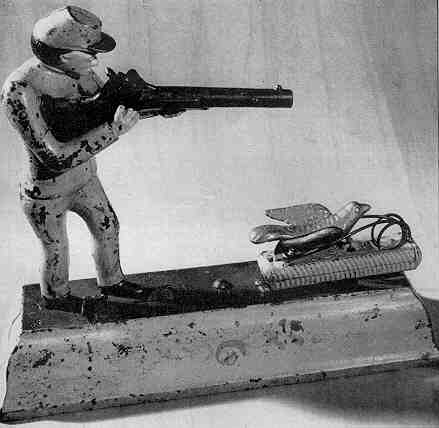Sportsman Bank
by F.H. Griffith - HOBBIES Magazine - June, 1952

The Sportsman Bank with its appealing subject, a hunter, plus its rarity and good action is the ninth ranking bank in our numerical listing.
The bank has a patent date of June 14, 1892 which is inscribed on the spring release mechanism that causes the bird to go flying through the air. It was manufactured by the J.&E. Stevens Company of Cromwell, Connecticut the most prolific of the bank manufacturers.
The pictured specimen was added to the writer’s collection through the help of Mr. Ellis who had the Ellis Old Toy Shop in Philadelphia, Pennsylvania. He obtained this bank from its original source in a home outside Philadelphia.
The bank has very nice action and operates as follows: First the loop spring that holds the bird is depressed and the bird placed thereon as shown. Then a coin is placed just forward of the hunter in a slot in the base, the lever is then pressed and all action takes place simultaneously. The bird goes flying off into the air and the hunter swings with the flight of the bird and fires his gun. A string attached to the bird pulls it down realistically just as though it had been shot. The gun is so arranged that it will fire a cap and of course this adds to the realism.
The bank is painted in nice colors, the base is yellow and red and the hunter in a tan outfit. The bird is gold.
As a rule when one of these banks turns up the bird is usually missing. Another drawback in finding this bank in original condition is the fact that the figure of the hunter is attached to the bank by a small casting which turns the figure and the entire part is very easily broken off.
The Sportsman Bank differs from most others in that the hunter’s figure is a smooth casting and the defining lines of the clothing are painted on. Usually the figures on the banks were cast with detail parts of the clothing defined, such as belts, ties, wrinkles, and the like.
It is interesting to note that this bank in recent years has been called the Fowler Bank by collectors. However, in old catalogs and Stevens’ literature it was definitely named the Sportsman Bank. There is no name cast on the bank itself.
The bank shown is original without repairs with the exception of the bird which is cast from an original specimen. The paint on the bank shows an interesting amount of wear in that it was obviously used by a child. In some cases banks are found in so called mint condition, that is they have had little or no use at all. Further, some have been found in original wood boxes. It is a matter of opinion as to preference in banks that show some wear or ones that are mint. Personally the writer prefers some signs of use but naturally with good paint.
There is also a difference of opinion as to leaving bank as they are found, dirty or not, or cleaning them up. Also, a few collectors keep banks in their collections whether they operate properly or not. The writer first takes apart any banks he gets and cleans them very carefully. Care must be used on painted parts as some of the old paints are soluble in soaps or scouring powders as made today. Every part is then waxed and reassembled and the bank put in perfect working order. After all, one of the most interesting things about mechanical banks is their fascinating operation. As to repainting a bank or touching it up, this should be avoided unless it is absolutely necessary. Here again it’s largely a matter of opinion.
Some banks are found repainted, the repainting having been done years ago. This was rather common in the mechanical bank period as toys were often repainted and given to the child over again at Christmas or a birthday. It’s possible to get down to the original paint when this has been done. Usually the bank was not cleaned before repainting and this leaves an oily surface between the old paint and repaint. Careful work and time can accomplish removal of the outer paint.
By the way, it would be good advice for antique dealers to leave banks as found and sell them that way. Many a bank has had its value decreased by poor repair work or removal of most of the paint by improper cleaning. Let the collector do with them as he chooses.
